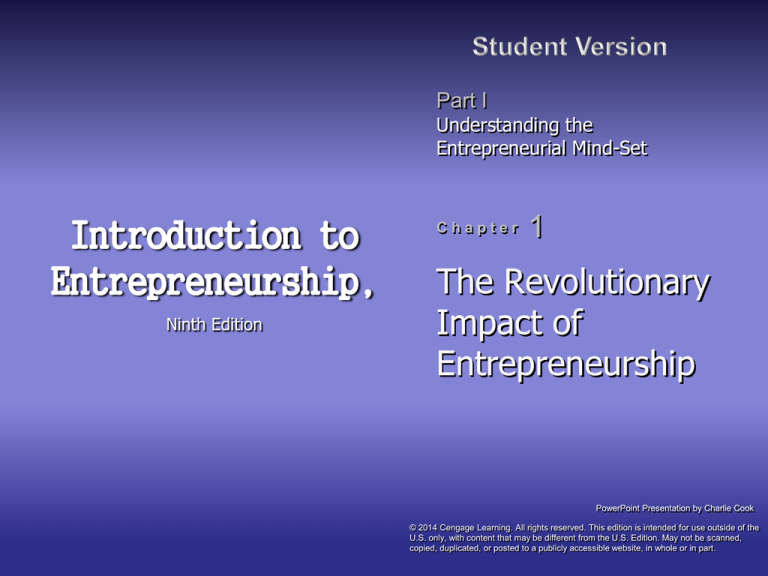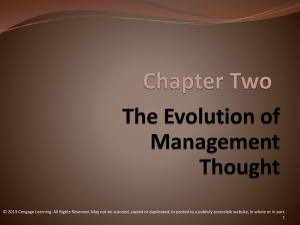
Part I
Understanding the
Entrepreneurial Mind-Set
Introduction to
Entrepreneurship,
Ninth Edition
Chapter
1
The Revolutionary
Impact of
Entrepreneurship
PowerPoint Presentation by Charlie Cook
© 2014 Cengage Learning. All rights reserved. This edition is intended for use outside of the
U.S. only, with content that may be different from the U.S. Edition. May not be scanned,
copied, duplicated, or posted to a publicly accessible website, in whole or in part.
Chapter Objectives
1.
2.
3.
4.
5.
6.
7.
To examine the historical development of
entrepreneurship
To explore and debunk the myths of entrepreneurship
To define and explore the major schools of
entrepreneurial thought
To explain the process approaches to the study of
entrepreneurship
To set forth a comprehensive definition of
entrepreneurship
To examine the entrepreneurial revolution taking place
today
To illustrate today’s entrepreneurial environment
© 2014 Cengage Learning. All rights reserved. This edition is intended for use outside of the U.S. only, with content that may be different
from the U.S. Edition. May not be scanned, copied, duplicated, or posted to a publicly accessible website, in whole or in part.
1–2
Entrepreneurs—Breakthrough Innovators
• Entrepreneurs
Recognize opportunities where
others see chaos or confusion
Are aggressive catalysts for
change within the marketplace
Challenge the unknown and
continuously create the future
© 2014 Cengage Learning. All rights reserved. This edition is intended for use outside of the U.S. only, with content that may be different
from the U.S. Edition. May not be scanned, copied, duplicated, or posted to a publicly accessible website, in whole or in part.
1–3
Entrepreneurship: A Mind-Set
• Entrepreneurship is more than
the mere creation of business:
Seeking opportunities
Taking risks beyond security
Having the tenacity to push
an idea through to reality
• Entrepreneurship is an integrated
concept that permeates an individual’s
business in an innovative manner.
© 2014 Cengage Learning. All rights reserved. This edition is intended for use outside of the U.S. only, with content that may be different
from the U.S. Edition. May not be scanned, copied, duplicated, or posted to a publicly accessible website, in whole or in part.
1–4
A Summary Description
of Entrepreneurship
• Entrepreneurship (Robert C. Ronstadt)
The dynamic process of creating incremental wealth.
This wealth is created by individuals who assume
major risks in terms of equity, time, and/or career
commitment of providing value for a product or
service.
The product or service itself may or may not be new or
unique but the entrepreneur must somehow infuse
value by securing and allocating the necessary skills
and resources.
© 2014 Cengage Learning. All rights reserved. This edition is intended for use outside of the U.S. only, with content that may be different
from the U.S. Edition. May not be scanned, copied, duplicated, or posted to a publicly accessible website, in whole or in part.
1–5
An Integrated Definition
• Entrepreneurship
A dynamic process of vision, change, and creation.
• Requires an application of energy and passion towards the
creation and implementation of new ideas and creative
solutions.
Essential ingredients include:
• The willingness to take calculated risks—in terms of time,
equity, or career.
• The ability to formulate an effective venture team; the creative
skill to marshal needed resources.
• The fundamental skills of building a solid business plan.
• The vision to recognize opportunity where others see chaos,
contradiction, and confusion.
© 2014 Cengage Learning. All rights reserved. This edition is intended for use outside of the U.S. only, with content that may be different
from the U.S. Edition. May not be scanned, copied, duplicated, or posted to a publicly accessible website, in whole or in part.
1–6
Macro View: External Locus of Control
• The Environmental School of Thought
Considers the external factors that affect a
potential entrepreneur’s lifestyle.
• The Financial/Capital School of Thought
Based on the capital-seeking process—the search
for seed and growth capital.
• The Displacement School of Thought
Alienation drives entrepreneurial pursuits
• Political displacement (laws, policies, and regulations)
• Cultural displacement (preclusion of social groups)
• Economic displacement (economic variations)
© 2014 Cengage Learning. All rights reserved. This edition is intended for use outside of the U.S. only, with content that may be different
from the U.S. Edition. May not be scanned, copied, duplicated, or posted to a publicly accessible website, in whole or in part.
1–7
Micro View: Internal Locus of Control
• The Entrepreneurial Trait School of Thought
Focuses on identifying traits common to successful
entrepreneurs.
• Achievement, creativity, determination, and technical
knowledge
• The Venture Opportunity School of Thought
Focuses on the opportunity aspect of venture
development—the search for idea sources, the
development of concepts, and the implementation of
venture opportunities.
• Corridor principle: New pathways or opportunities will arise
that lead entrepreneurs in different directions.
© 2014 Cengage Learning. All rights reserved. This edition is intended for use outside of the U.S. only, with content that may be different
from the U.S. Edition. May not be scanned, copied, duplicated, or posted to a publicly accessible website, in whole or in part.
1–8
Micro View… (cont’d)
• The Strategic Formulation School of Thought
Emphasizes the planning process in successful
venture development.
Strategic formulation is a leveraging of unique
elements:
• Unique Markets—mountain gap strategies
• Unique People—great chef strategies
• Unique Products—better widget strategies
• Unique Resources—water well strategies
© 2014 Cengage Learning. All rights reserved. This edition is intended for use outside of the U.S. only, with content that may be different
from the U.S. Edition. May not be scanned, copied, duplicated, or posted to a publicly accessible website, in whole or in part.
1–9
Process Approaches to Entrepreneurship
• An Integrative Approach
Built around the concepts of inputs to the
entrepreneurial process and outcomes from
the entrepreneurial process.
Focuses on the entrepreneurial process itself
and identifies five key elements that contribute
to the process.
Provides a comprehensive picture regarding
the nature of entrepreneurship that can be
applied at different levels.
© 2014 Cengage Learning. All rights reserved. This edition is intended for use outside of the U.S. only, with content that may be different
from the U.S. Edition. May not be scanned, copied, duplicated, or posted to a publicly accessible website, in whole or in part.
1–10
Process Approaches… (cont’d)
• Dynamic States Approach
Stresses dependency of venture on environment and
the interaction of:
• The dominant logic of the firm
• The business model
• Value creation
© 2014 Cengage Learning. All rights reserved. This edition is intended for use outside of the U.S. only, with content that may be different
from the U.S. Edition. May not be scanned, copied, duplicated, or posted to a publicly accessible website, in whole or in part.
1–11
Entrepreneurial Ventures in the United States
• Reasons for the exceptional entrepreneurial
activity in the U.S. include:
A national culture that supports risk taking and
seeking opportunities.
Americans’ alertness to unexploited economic
opportunity and a low fear of failure.
U.S. leadership in entrepreneurship education at
both the undergraduate and graduate level.
A high percentage of individuals with professional,
technological or business degrees who are likely to
become entrepreneurs.
© 2014 Cengage Learning. All rights reserved. This edition is intended for use outside of the U.S. only, with content that may be different
from the U.S. Edition. May not be scanned, copied, duplicated, or posted to a publicly accessible website, in whole or in part.
1–12
The Impact of Gazelles
• A “Gazelle”
A business establishment with at least 20% sales
growth in each year for five years, starting with a
base of at least $100,000 in annual sales.
• Gazelles as leaders in innovation:
Produce twice as many product innovations per
employee as do larger firms.
Are responsible for 55% of innovations in 362
different industries and 95% of radical innovations.
Obtain more patents per sales dollar than do
larger firms.
© 2014 Cengage Learning. All rights reserved. This edition is intended for use outside of the U.S. only, with content that may be different
from the U.S. Edition. May not be scanned, copied, duplicated, or posted to a publicly accessible website, in whole or in part.
1–13
Gazelles And Survival
• How many gazelles survive?
The simple answer is “none.”
Sooner or later, all firms wither and die.
• The Common Myth of Failure:
85% of all firms fail in the first year—in actuality, about
half of all start-ups last between 5 and 7 years.
© 2014 Cengage Learning. All rights reserved. This edition is intended for use outside of the U.S. only, with content that may be different
from the U.S. Edition. May not be scanned, copied, duplicated, or posted to a publicly accessible website, in whole or in part.
1–14
Legacy of Entrepreneurial Firms
• Entrepreneurial components
of the U.S. Economy:
1.
Large firms have increased profitability by returning
to their “core competencies through restructuring
and downsizing.
2.
New entrepreneurial companies have been
blossoming in new technologies and new markets.
3.
Thousands of smaller firms established by women,
minorities, and immigrants have strengthened the
economy.
© 2014 Cengage Learning. All rights reserved. This edition is intended for use outside of the U.S. only, with content that may be different
from the U.S. Edition. May not be scanned, copied, duplicated, or posted to a publicly accessible website, in whole or in part.
1–15
Entrepreneurial Firms’ Economic Impact
• Entrepreneurial firms make two indispensable
contributions to an economy:
1. They are an integral part of the renewal process that
pervades and defines market economies.
2. They are the essential mechanism by which millions
enter the economic and social mainstream of society.
© 2014 Cengage Learning. All rights reserved. This edition is intended for use outside of the U.S. only, with content that may be different
from the U.S. Edition. May not be scanned, copied, duplicated, or posted to a publicly accessible website, in whole or in part.
1–16
21st Century Trends in Entrepreneurship Research
Venture
Financing
Corporate
Entrepreneurship
Entrepreneurial
Cognition
Global
Entrepreneurial
Movement
Social
Entrepreneurship
Trends in
Entrepreneurship
Research
Women
and Minority
Entrepreneurs
Entrepreneurial
Education
Family
Businesses
© 2014 Cengage Learning. All rights reserved. This edition is intended for use outside of the U.S. only, with content that may be different
from the U.S. Edition. May not be scanned, copied, duplicated, or posted to a publicly accessible website, in whole or in part.
1–17
Key Concepts
• Entrepreneurship
A process of innovation and new-venture creation
through four major dimensions—individual,
organizational, environmental, and process—that is
aided by collaborative networks in government,
education, and institutions.
• Entrepreneur
A catalyst for economic change who uses purposeful
searching, careful planning, and sound judgment
when carrying out the entrepreneurial process.
© 2014 Cengage Learning. All rights reserved. This edition is intended for use outside of the U.S. only, with content that may be different
from the U.S. Edition. May not be scanned, copied, duplicated, or posted to a publicly accessible website, in whole or in part.
1–18







